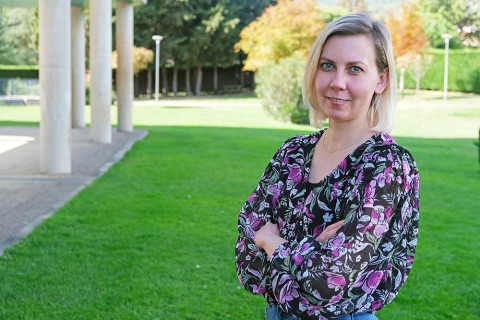Sylwia Pawledzio joins the Spanish Line of the European synchrotron in Grenoble

The team of the Spanish CRG beamline at the ESRF (Grenoble, France) is growing. Together with Shunya Yan, whom we met recently, another new colleague has just joined this leading center. She is Sylwia Pawledzio, a Polish scientist expert in quantum crystallography who loves hiking and traveling.
Where do you come from?
I am originally from Poland, but for the last two years I lived in the USA, where I worked at Oak Ridge National Laboratory.
What have you worked on so far?
My research background combines crystallography, quantum crystallography, and advanced diffraction methods. I am an experimentalist with extensive experience in single-crystal diffraction at synchrotron and neutron facilities worldwide, including SOLEIL, PSI, Spring-8, APS, and ORNL.
At Oak Ridge National Laboratory, I worked at the TOPAZ beamline, where I conducted my own experiments and supported users in neutron diffraction studies, including those performed under extreme conditions.
I have developed expertise in collecting high-resolution, high-precision, and high-accuracy data for organometallic complexes, minerals, different phases of ice, and pharmaceutical compounds. In addition, I have a strong background in computational chemistry, which I integrate with advanced experimental techniques. Most recently, my work has focused on direct air capture (DAC) materials, where I applied quantum crystallography approaches to study hydrogen bonding and intermolecular interactions (published in JACS).
These efforts position me as both a quantum crystallography expert and a single-crystal experimentalist dedicated to pushing the boundaries of structural and electron density analyses.
What will you work on? With whom?
At BM25-SpLine, I will work on developing single-crystal diffraction capabilities and applying combined synchrotron and neutron methods and quantum crystallography to study a wide range of functional materials. I look forward to collaborating with colleagues at ICMM-CSIC, ESRF, and our broader international network to support user experiments and advance research in crystallography and material science.
Why ICMM?
ICMM provides me the opportunity to work at one of the world’s leading synchrotron facilities, the ESRF, and to collaborate with outstanding experts in crystallography and materials research. Joining ICMM allows me to continue developing advanced crystallographic methods while contributing to the success and visibility of the Spanish CRG beamline.
And a personal touch: any hobbies? What would you like to contribute to the institute?
Outside of work, I enjoy hiking, traveling, and exploring new cultures. I also practice pole sport and calisthenics, which help me stay active and creative.
At ICMM, I hope to contribute not only with my scientific expertise but also by fostering collaborations, supporting young researchers, and helping to build a vibrant and internationally connected scientific community.
ICMM
Sor Juana Ines de la Cruz, 3
Cantoblanco, 28049
Madrid, España
Teléfono: (+34) 91 334 90 00
Email: @email
Oficina de Comunicación/Prensa: @email

Acknowledge the Severo Ochoa Centres of Excellence program through Grant CEX2024-001445-S/ financiado por MICIU/AEI / 10.13039/501100011033

Contacto | Accesibilidad | Aviso legal | Política de Cookies | Protección de datos